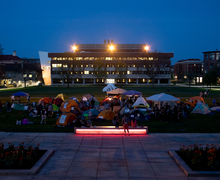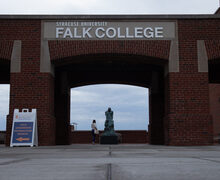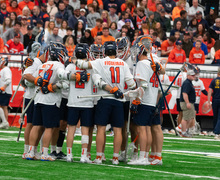Construction is almost complete on the Syracuse Biomaterials Institute, located on the third and fourth floors of Bowne Hall.
Construction to convert chemistry-teaching labs to SBI research labs began in October 2009, said Sara Miller, associate director of news services at Syracuse University. The project will be completed in October, with the exception of first and second floor hallway improvements, which will be scheduled for completion over semester breaks, Miller said.
Biomaterials are natural and synthetic substances designed to treat, augment, or replace tissues and organs of the human body as treatments to disease or injury, according to the institute’s website.
The biomaterials institute is composed of faculty members from SU, the State University of New York College of Environmental Science and Forestry and the Upstate Medical University Hospital. SBI also hosts undergraduate and graduate research opportunities.
‘It capitalizes on existing strengths in biomaterials that were already at SU,’ said Jay Henderson, an assistant professor in SU’s Department of Biomedical and Chemical Engineering. ‘It’s not starting from scratch. It’s building on.’
Undergraduate and graduate students will be able to use the lab as a shared space for studies on cell culture and tissue engineering, molecular biology, polymer synthesizing and polymer characterization, Henderson said.
Although the institute started in 2007, this will be the first time the institute has a physical location, Henderson said. The project was made possible in part through an alumnus gift, but he said he was unaware of the donated amount or overall project cost.
The SBI has been developing for some time, said Jeremy Gilbert, founder and professor of biomaterials, in an e-mail.
Gilbert said SU did not have a biomaterials department before he arrived to SU in 1999. The following year, he and associate professor Julie Hasenwinkel developed The Biomaterials Group, a volunteer group of interested faculty and graduate and undergraduate students.
Gilbert said he began to advocate for an official campus-wide biomaterials initiative in 2004, when he was associate dean for research in the L.C. Smith College of Engineering and Computer Science. When L.C. Smith received the Milt and Ann Stevenson Chair, its first endowed faculty chair, in 2006, the Department of Biomedical Engineering was able to seriously look into finding and recruiting Patrick Mather as director for the institute, Gilbert said.
He said SBI did not officially take shape until 2007. The Bowne construction will give the institute a place on campus, Gilbert said.
‘The new space is definitely a way to give the institute a real home and to provide a focused, integrated and collaborative research environment,’ Gilbert said.
Offices will occupy about a quarter of the third floor, and the entire fourth floor will be research labs. Faculty and administrators will move in within the next few weeks, and labs and student offices will be occupied by the end of October.
Henderson and Gilbert will be joined in the building by SBI Director Patrick Mather, associate professor Julie Hasenwinkel and assistant professor Rebecca Bader.
The SBI will allow for a level of collaboration currently not practical, Henderson said.
The space is designed to encourage collaboration through interwoven public spaces and laboratories, Mather said in e-mail.
The university has maintained the historic architecture of Bowne, Mather said. The fourth floor will incorporate the building’s original high ceilings, and decorative steel trusses have stayed.
‘We are very excited about the new space,’ Mather said. ‘The equipment we have and the beautiful designed space will make it the preeminent location to conduct biomaterials research in our region, if not the entire nation.’
Mather said without the institute, local efforts to study science and technology in the field of biomaterials would be uncoordinated.
With it, Mather said, the group is able to conduct research into topics like the development of smart medical devices that can be deployed in the body upon command by a surgeon to heal an injury or treat a disease.
William Winter, a professor in the ESF department of chemistry, is studying polymers at the institute.
Winter said he expects SBI to be around for years to come and gain a positive national reputation.
‘It’s a way to bring people together who have broad similar interests and also special interests,’ Winter said.
Since the physical location will be at SU, it will primarily serve SU students and researchers, he said. Students will travel between labs at ESF or SU, depending on classes.
But Winter said the collaboration between the schools would be an asset to researchers and students involved, no matter which university they were associated with.
‘This is a very good example of the kind of collaboration that strengthens the universities,’ Winter said.
Published on September 8, 2010 at 12:00 pm
Contact Dara: [email protected] | @daramcbride




